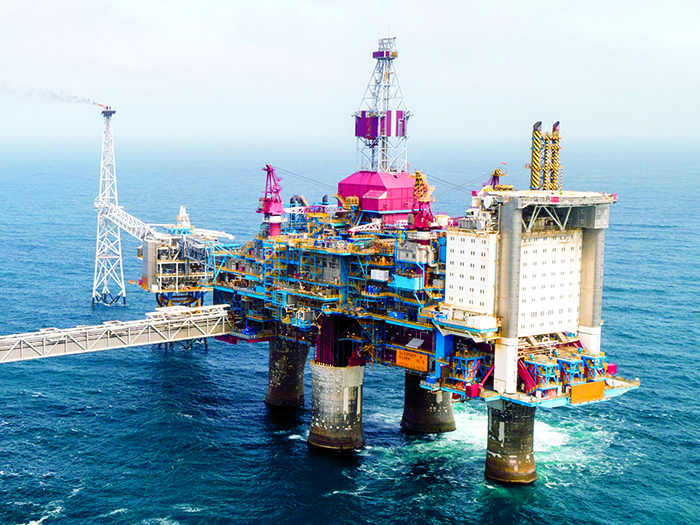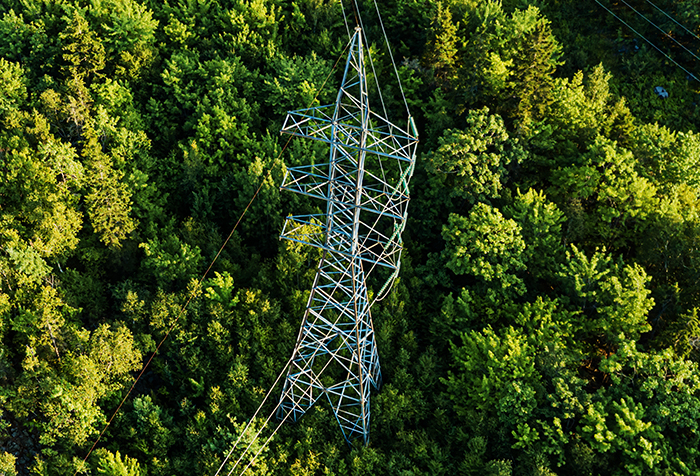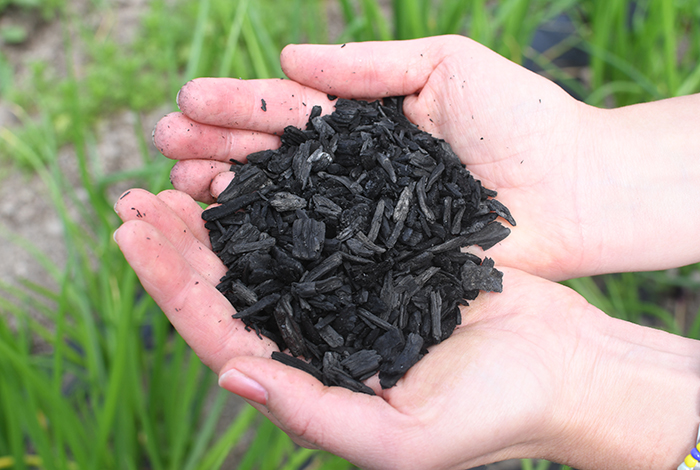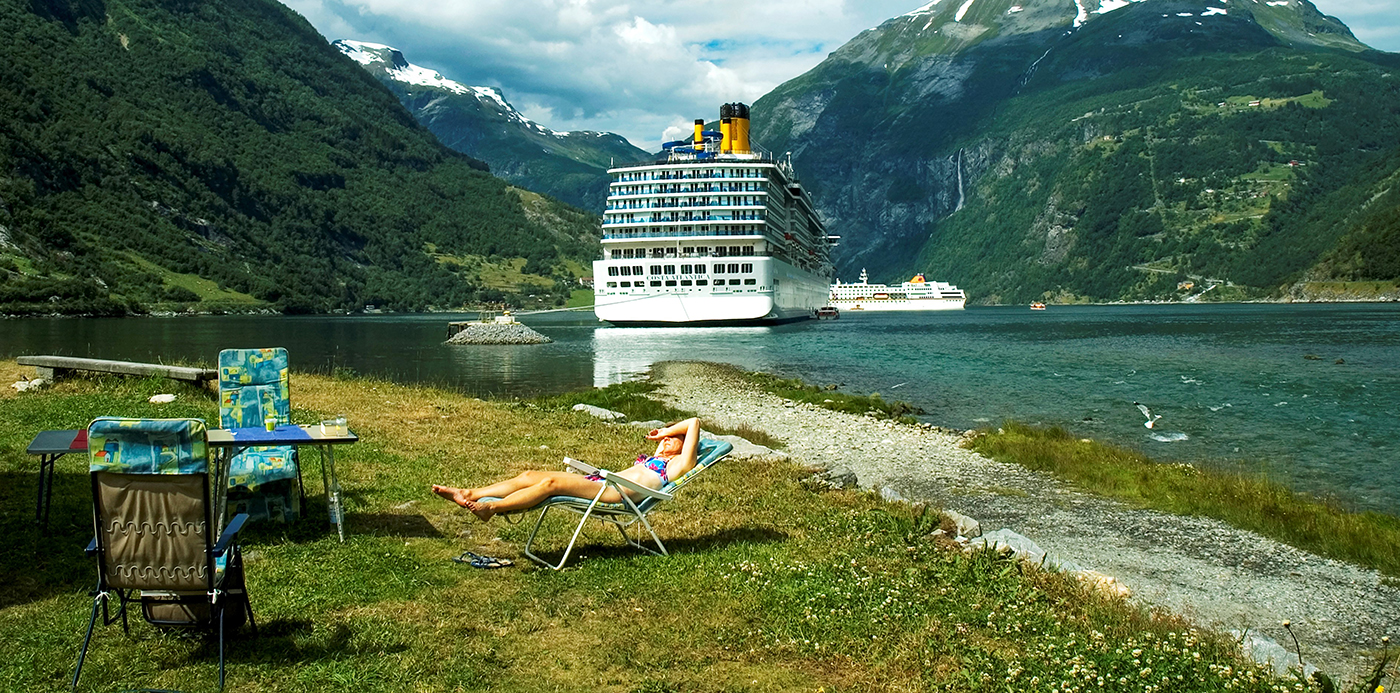As our energy demands increase, the planet continues to overheat. But there is hope.
A cure for global warming: Technologies exist that can get us out of this mess. Let’s take a look at them.
Some are expensive and others free of charge. Some are complex while others are very straightforward. But they all share one thing in common. They are available today, and it up to us to choose to utilise them – or not. It will be incredibly expensive to do nothing.
“It’s all about what the general public do, and the decisions that politicians make”, says Edgar Hertwich, who is a Professor at the Department of Energy and Process Engineering at NTNU.
“What are you thinking about?
“To put it simply, political governance”, he says. “With just a small adjustment in pricing, people will make different choices.
Hertwich sits on the EU’s new Climate Panel, which in January 2024 published a report on how the EU countries can achieve zero emissions by 2050.
“The most important conclusion we arrived at was that all subsidisation of fossil energy production and use should be stopped. This sounds rather like a recommendation directed at countries such as Venezuela or Saudi Arabia, doesn’t it?
A Gordian knot
There is little doubt that the planet is overheating, while at the same time our demands for energy are increasing. And as if this wasn’t enough of a paradox, there continue to be sceptics who argue that it is too expensive, too late and technically impossible to untie the knot. Others believe that we must accept reductions in our standards of living – right down to the lowest common multiple.
“It’s all about what the general public do, and the decisions that politicians make”
But there is a third way. We can utilise smart technologies that are sitting right in front of our noses. Off-the-shelf technologies that only need a nudge or two in the right direction. So, yes indeed, there is still hope.
A Norwegian miracle?
Take the EU, for example. In 2022, emissions from EU countries were more than 30 per cent lower than in 1990. Last year, these countries succeeded in cutting yet another five per cent without any reduction in their standards of living. Norway has reduced its emissions by only five per cent in the last 30 years, and it is still the case that half of all the energy used in this country is derived from fossil sources.
“If we are to reach our targets, we will have to make cuts of an additional 45 percent and get this done within the next six years. In fact, we need a miracle cure”, says Nils Røkke, who is Executive Vice-President for Sustainability at SINTEF.
“The planet is already suffering badly enough. But there do exist solutions that perhaps you haven’t heard about, and some of these are just waiting to be utilised.
Røkke is also President of the European Energy Research Alliance (EERA) and believes that a billion kroner must be found urgently to fund green energy research in Norway. This amount must then be doubled in 2030.
But the reality is just the opposite. The last three years have seen a real decline of 21 per cent in energy research funding. And all this while the need for zero-emissions energy is becoming ever more urgent.
“We must utilise the technologies we have now, even if they’re not profitable in the short term”, says Røkke.
“If we are to reach our targets, we will have to make cuts of an additional 45 percent and get this done within the next six years. In fact, we need a miracle cure”
“Profitability must always be balanced against the ultimate cost of emitting all this CO2.
In 2008 we succeeded in doubling our investment in energy research, so it’s perfectly possible to reverse the current trend”, he says.
FOREST WILDFIRES

The planet is literally burning. Wildfires are bigger and are occurring more often. They emit enormous volumes of CO₂ into the atmosphere. Since 2022, the EU countries have reduced their emissions by 30 per cent, but Norway has achieved reductions of between only five and six per cent. The message from researchers is that there is no time to lose in utilising the many technologies available to us, even if this is not profitable in the short term. The alternative will be much more expensive.
Photo: JasonDoiy/iStock
Don’t waste heat
Consuming less energy is something we can do that literally also makes a difference. A benefit of not wasting heat is that the actions we need to achieve it have no negative impact on natural resources or biodiversity.
“One of the most effective things we can do is to practice energy efficiency wherever possible, and this doesn’t have to mean reducing our living standards or being less happy in our lives”. So says NTNU Professor Asgeir Tomasgard, who goes on to add:
“Our buildings, for example, must become more energy efficient and, not least, energy positive. This means that they should generate more energy than they consume. And we must have this in mind in the early stages of building design”, he says.
In addition to his professorship and role as Director at NTNU Energi, Tomasgard participates on many international committees and working groups.
Concrete is the most utilised of all building materials and accounts for between five and eight per cent of all global greenhouse gas emissions. However, it is possible to make concretes in far more eco-friendly ways, and at the same time construct buildings that can stand the test of time. And this can all be achieved using reusable materials.
“One of the most effective things we can do is to practice energy efficiency wherever possible, and this doesn’t have to mean reducing our living standards or being less happy in our lives”
“Eco-friendly construction is a little more expensive”, says Tomasgard. “For this reason, politicians have to try harder to remove the doubt in developers’ minds that it is worth the additional investment. To achieve this, we must raise our ambitions and build more energy-positive buildings that will reveal their cost-effectiveness in the long term. We must make sure that we take the long view when it comes to the sum total of investments and operational costs across the entire lifetime of our buildings”, he says.
Bottlenecks in the electricity grid
Much of our energy is lost on its way to the consumer. Indeed, up to ten per cent of all the electricity generated in Norway is wasted. Losses from the distribution grid increase with distance of transmission.
“Today, the distribution grid has developed into an energy bottleneck, but we have the technologies that can make the grid more flexible”, says Tomasgard. “We can also control electricity consumption related to everything from hot water tanks to EV charging, and by adopting consumption habits that enable us to use electricity when it is cheapest”, he says.
The logic is very straightforward. When we reduce peak load in the distribution grid, we create more capacity.
“Making the grid flexible depends once again on the electricity price”, says Tomasgard. “If it saves money to delay turning on the heating or charging the car by fifteen minutes, or even an hour, then consumers will do it”, he says.
But we must also give businesses and others the opportunity to trade electricity with each other. This can be done simply by establishing a flexible electricity market that enables high-volume consumers to get access to electricity when capacity is under the greatest strain.
“If it saves money to delay turning on the heating or charging the car by fifteen minutes, or even an hour, then consumers will do it”
The good news is that the world’s first scheme involving the trading of surplus electricity between buildings is up and running – in Trondheim in Norway.
A THRIFTY SOLUTION

This local grocery store in Trondheim runs on about two-thirds of the electricity consumed by other similar-sized stores. It achieves this thanks to technology that involves the smart exploitation of surplus heat and electricity. Many technologies that promote smart energy use have come onto the market. Here is researcher Armin Hafner taking a look at the store’s energy-saving refrigerator system.
Photo: Thor Nielsen/SINTEF
A smart neighbourhood
At Brattøra in Trondheim, close to the high-speed terminal, there are some big buildings that have entered into a unique general partnership. All of them are generating more electricity than they consume. The Clarion Hotel, with a view across the fjord to Munkholmen island, stands right next door to the Pirbadet swimming baths.
The Powerhouse building adorns the other side of the street. This is a high-tech, energy-positive construction, with a façade totally covered in solar panels. Just next door is the campus of the BI Business School.
Surplus electricity from these buildings is stored in enormous batteries that other buildings in the area can purchase when they need it. These include the Rockheim Museum, a converted warehouse now belonging to the company Trondheim kjøle- og fryselager, and the heated pedestrian bridge that connects Brattøra with the centre of the city.
Electric buses can also charge from the same enormous batteries that are installed between the buildings at Brattøra.
At Sluppen in the south of the city, developers are in the process of constructing a combined residential and industrial complex, also installed with smart energy systems.
However, the roll-out of such developments across the entire country is at risk of being obstructed by something as mundane as Norwegian legislation. Current regulations require a licence for the sale and purchase of electricity. In Trondheim, politicians have been campaigning for many years to obtain a dispensation from these regulations, and have finally be given the green light.
EU – yet again top of the class
The schemes running at Brattøra and Sluppen were made possible by funding from the EU smart city project ‘+CityxChange’. “This has not only made ample budgets available, but has also promoted political visibility”, says NTNU Professor Annemie Wyckmans, who has been heading the project.
“We’re doing this because cities and other built-up areas have the potential to play a much greater role in society’s transition in response to climate change”, says Wyckmans.
For example, she believes that underground parking garages can be installed with geothermal heat pumps or thermal energy storage systems. This will save money and space, and at the same time reduce greenhouse gas emissions.
“Innovative engineering solutions make it possible to use electric vehicles as mobile batteries”, says Wyckmans. “EVs will no longer simply be a means of transport. It’s perfectly possible to use EVs to power buildings and support charging infrastructure for electric buses and goods vehicles”, she says.
“Innovative engineering solutions make it possible to use electric vehicles as mobile batteries”
“In many European countries, the purchase and sharing of energy among neighbourhood communities is already standard practice and is supported by comprehensive legislation.
Powerhouse Brattøra
AN ENERGY PARTNERSHIP

At Brattøra in Trondheim, a small piece in the climate change mitigation puzzle is already in place. Three large buildings have entered into a unique general partnership. Each stores its own energy and shares the surplus with neighbouring businesses. What’s not to like?
Photo: Christina Benjaminsen/SINTEF
Heat pump the size of a car
What we do today has consequences, not only for ourselves, but also for our grandchildren, their children, and perhaps for 30 or 40 generations into the future. In 2030 it will be prohibited to use fossil fuels in the industrial sector in Norway. All energy must come from renewable sources.
About twenty-five per cent of Norway’s energy production takes place in the process industries. The temperatures here are very high, and inevitably the heat is simply wasted as it disappears into thin air.
According to SINTEF, these industries alone account for 20 TWh of recoverable surplus heat. For comparison, this represents the energy consumed by the inhabitants of Norway’s capital Oslo, every year, and a little extra.
Half of all our global energy is used for heating or cooling, but it all depends. And for processes taking place at hundreds and even thousands of degrees, the hotter the temperature, the more important it is to capture the surplus heat – either in the form of energy to keep the machines and furnaces running in the same building, or by not letting it go to waste – but instead conducting it away for use in other processes or for heating neighbouring buildings or homes.
Researchers at SINTEF and NTNU have been working for some time to develop heat pumps that can upgrade surplus heat from industrial processes. This isn’t about machines designed to provide a little household comfort, but heat pumps the size of a car that can elevate temperatures from 95 to 140°C or more.
An example of one such ‘super heat pump’ is the Osenbrück 4.0. This machine is installed in a basement in the SINTEF building at Gløshaugen in Trondheim. It represents the tangible result of work carried out jointly at the Research Council of Norway’s HighEFF centre (a Norwegian project designed to promote energy efficiency in the industrial sector) and as part of a four-year EU project called ENOUGH.
“Apart from having been constructed in Norway, the Osenbrück 4.0 is unique because it is oil-free and utilises the easily accessible working medium ammonia and water”, explains Armin Hafner. Hafner is a Professor at NTNU and is regarded as one of the world’s most prominent researchers in the field of heat pumps and refrigeration systems.
“A heat pump like this acts as a temperature lift in a process plant and can boost the output of renewable energy many times over”
“Being oil-free means that the Osenbrück 4.0 requires relatively little maintenance. It is less expensive to manufacture and easier to deal with in all other respects”, says Hafner.
So, what does it do? It enables the future refrigeration, freezing, storage and transport of foodstuffs with a minimum of the cleanest possible emissions.
“A heat pump like this acts as a temperature lift in a process plant and can boost the output of renewable energy many times over”, says Hafner. “The size, that is to say the performance capacity, of such a plant may be several megawatts, equivalent to multiple tonnes of steam per hour”, he says.
A PROBLEM – BUT ALSO PART OF THE SOLUTION

The oil and gas sector has made a major contribution to the planet’s climate problems. However, it also offers a possible solution. The message from researchers is clear. Without carbon capture and storage (CCS), we will not make any progress in checking the rate of climate change. We have been using Utsira Formation reservoirs in the North Sea for storing CO2 since 1996. We know exactly how to do it and we know that it is safe. But the volumes of gas stored must be increased by at least an order of magnitude.
Photo: Øyvind Gravås and Bo B. Randulff/Equinor
Can make 40 windfarms unnecessary
Researchers at NTNU and SINTEF believe that it is entirely possible to halve the energy consumption of the buildings we already have standing. This means that by 2050 we can rescue natural habitats from the development of about 40 onshore windfarms similar to that at Storheia in Fosen in Trøndelag.
“The most cost-effective measures we can implement are the retro-insulation of cold attic space, combined with the installation of air-to-air heat pumps”
If we look to 2030, just five or six years ahead, the rescue will be of the order of 13 TWh, which is equivalent to the energy generated by 1,000 turbines, or the annual electricity consumption of the combined populations of Bergen and Trondheim.
Energy-saving measures in buildings can be seen as a form of ‘hidden power station’ – one that will be the biggest of its kind in Norway, without us having to construct anything new. All of this is something that Lars Gullbrekken, a Research Manager at SINTEF, knows a lot about because he has been working on this issue for 14 years.
“The most cost-effective measures we can implement are the retro-insulation of cold attic space, combined with the installation of air-to-air heat pumps”, says Gullbrekken.
It is almost always more eco-friendly to ‘energy upgrade’ and identify intelligent solutions rather than demolish a building. But if we have to demolish, we must also have materials reuse in mind. Brickwork is a good example. It is also crucial to ensure that concrete, which is one of our most important building materials, is as eco-friendly as possible.
There is in fact an article in this edition about this very topic; concrete with an almost unlimited lifetime can currently be manufactured with an 80 per cent reduction in its climate footprint.
No go without carbon capture
But intelligent solutions for smart resource exploitation will not be enough. There is no escaping the fact that we have to capture carbon dioxide gas and put it into permanent storage.
“We won’t achieve our targets unless we implement carbon capture and storage (CCS)”, says Nils Røkke, who is Executive Vice-President for Sustainability at SINTEF.
“It’s simply not possible to electrify absolutely everything, and this is why we have to implement CCS”
There are roughly three ways to reduce the harmful effects of greenhouse gas emissions. The first is to actually reduce the volume of emissions. The second is to remove CO2 from the atmosphere, and the third is to buy ourselves time with the help of so-called geoengineering. The last of these is controversial because it involves blocking the sun’s radiation to the planet.
“It’s simply not possible to electrify absolutely everything, and this is why we have to implement CCS”, says Røkke, who has been a campaigner for the use of this technology for more than 20 years.
The UN Intergovernmental Panel on Climate Change, which is a forum for the world’s most prominent researchers, agree. Røkke explains that the EU has moved from scepticism on CCS to now arriving at an annual target of 50 million tonnes of storage by 2030. This is as much as Norway as a whole emitted last year. The EU’s aim is to increase this annually to 280 and 450 million tonnes in 2040 and 2050, respectively.
“CO2 management has enjoyed a renaissance in the wake of new regulations and legislation now being prepared by the EU”, says Røkke. “The new system returns responsibility to those that generate the emissions in the first place. It will operate just like a Norwegian bottle bank”, says Røkke.
However, here in Norway, we are lagging behind. But something is happening and we will see the outcome as early as next year.
A plan being prepared by the Norwegian authorities for the safe management of CO2 is about to be rolled out. As part of a pilot project, the gas will first be captured from industrial processes, which in this case will involve a cement factory owned by Heidelbergs Materials in Breivik and a combustion facility owned by Hafslund Oslo Celsios. The CO2 will then be liquefied before being transported for interim storage at Øygarden near Bergen.
From here the gas will be pumped via pipelines into subsea storage reservoirs at 2,600 metres depth. The project is called ‘Langskip’ (Longship) and is Europe’s first full-scale CO2 management project. Never before have the Norwegian authorities invested so much money in a single climate change mitigation project – NOK 20 billion of the total cost of NOK 30 billion.
“It is Norway that has been responsible for all the CO2 stored in Europe since 1996, when we started storage operations at the Sleipner field “, says Røkke.
“This technology is a precondition for any chance we have of achieving our climate change mitigation targets, but the Langskip project will not be enough to finish the job”, he says. “We will need many more projects of this kind if we are to get anywhere close.
“It is Norway that has been responsible for all the CO2 stored in Europe since 1996, when we started storage operations at the Sleipner field “
On the bright side, you can say that Norway has more than enough storage capacity in its subsea reservoirs. We have both the entire North Sea and Norwegian Sea, which together represent the biggest potential CO2 storage capacity in all of Europe. But it takes as much as five to ten years to qualify an individual reservoir for CO2 storage. So we don’t have much time”, says Røkke.
NATURE’S VERY OWN GEOENGINEERING

According to the Norwegian Climate Research Centre Cicero, particles from a major volcanic eruption, by reflecting some of the sun’s radiation back into space, are able to cause a cooling of the Earth of between 0.2 to 0.4 degrees over a period of one to three years, depending on how the ash and dust clouds ascend. Because global temperatures are rising faster than researchers first thought, an increasing number of scientists believe that we have to buy ourselves some time. By this they mean that we must find man-made solutions to screen the planet from soar radiation.
Photo: AdobeStock
Winning by the wind?
When it comes to wind energy, this is easily captured and its benefits are attractive to CO2 emissions statisticians. Wind power is profitable and efficient. The technology is familiar and ready to roll out. However, as we are now well aware, its implementation faces a great deal of opposition linked to the destruction of natural landscapes and habitats. In the future, wind farms will be installed at sea – supposedly out of sight and out of mind.
At least, this is what Norwegian politicians believe. In Norway, the current target is to award concessions for the building of 30 gigawatts of offshore wind capacity by 2040. When this infrastructure is completed, the country will be generating about 150 TWh of energy every year. For comparison, according to figures from Statistics Norway, the entire country consumed about 140 TWh in 2021.
“The world’s first floating offshore wind turbine was installed in Norway as early as in 2009”, says Research Manager John Olav Giæver-Bie Tande at SINTEF Energy Research.
In 2019, Tande was awarded the title of ‘Mission Innovation Champion’ as international recognition for his research into offshore wind power. The prize was inaugurated by Bill Gates and Barack Obama.
It was research carried out at SINTEF that enabled Equinor to build Hywind, the world’s first commercial offshore windfarm, which is located 30 kilometres offshore of the town of Peterhead in Scotland.
“Norway has now reached a unique crossroads”, says Tande. “Not only are developments in offshore wind technology able to meet increasing demands for clean energy, but they may also form the basis of a major and competitive supply sector”, he says.
SINTEF is also heading a research centre called NorthWind, which has ambitions to contribute towards the profitable export of energy generated by offshore wind, cut costs and ensure that negative environmental impacts are kept to a minimum. But how much of the North Sea has to be expropriated in order to meet these energy needs?
“This depends on how close together the turbines are installed”, says Tande. “However, a reasonable estimate is an area of about 6,000 square kilometres”, he says.
Just to put things in perspective, this represents just four one thousandths of the marine area available, if we consider the North Sea and the Norwegian Sea taken together.
“A number of floating turbine concepts are currently being developed and tested here in Norway”, says Tande. “In general, floating turbines are installed in sea depths greater than between 60 and 70 metres, while bottom-fixed turbines are utilised in shallower waters”, he says.
But the development of offshore windfarms is expensive. In brief, according to Tande, we need three things to be in place in order to keep costs low – development, research and innovation.
A balancing act
Hydropower currently meets 87 per cent of Norway’s electricity requirements and accounts for about half of all its energy consumption. It may then perhaps seem a little strange that some people think we should be extracting even more from this resource. But there is plenty more energy to capture. Twenty per cent more, in fact.
The great benefit of hydropower is that we can open the sluices exactly when the demand for electricity arises. And if we utilise pump-fed power stations, it becomes possible to balance our access to the electricity.
“Hydropower can adjust for the entire power balance existing between the clean energy sources in Norway”.
This is the view of Ole Gunnar Dahlhaug, who works at the NTNU Hydropower Laboratory, known as the university’s ‘most profitable building’.
Professor Dahlhaug explains that when electricity prices are low, the smart thing to do is to pump water from one reservoir to another at a higher elevation. And then, when prices are high, release the water and generate more energy.
“Hydropower can adjust for the entire power balance existing between the clean energy sources in Norway”.
In fact, this very idea was outlined in a report published in 2023 in which researchers at Gløshaugen in Trondheim set out their analysis of the Norwegian energy situation and offered their advice to national politicians.
“We can explain this using a car”, says Dahlhaug. “Imagine that you want to drive up a steep hill in a small car towing a heavy caravan. It’s not enough simply to have sufficient battery capacity or petrol in your tank. You also have to use these to generate enough output to get everything to the top of the hill”, he says.
Dahlhaug says that the media often get confused.
“When we say that we want to double the output of a hydropower plant, this has nothing to do with energy at all”, he says. “It’s about having bigger turbines that enable us to generate sufficient output on days when the wind isn’t blowing”, he says.
“It’s a fact that hydropower reservoirs are the least expensive batteries in the world”, he adds. “If Norway wants to develop offshore wind power to meet the aims stated by the current government, then our hydropower plants will have to offer greater levels of output.
LIMITED CAPACITY

There is only limited capacity remaining in the Norwegian electricity distribution grid and for this reason, we have to take steps to reduce the load on the system. Such steps include smart electricity pricing, the sharing of surplus energy and, not least, the construction of more so-called ‘plus houses’ that generate their own electricity. In short, we must use our electricity as efficiently as possible while at the same time reducing our need for it.
Photo: iStock
Solar power? – Yes, even in Norway
Solar power can be profitable, even as far north as in Norway. Solar cells are relatively inexpensive to manufacture, and no-one is manning the barricades to protest against their use. Moreover, their production creates green jobs.
“In a few decades, and in combination with wind power, solar energy will emerge as the primary driver of global energy production”. This is the view of Steve Völler, who is an electrical power engineer at NTNU, and who has been working with solar energy and energy storage for many years.
“We’re talking about an infinite resource”, he says. “Solar cells are easy to use and have long lifetimes of between twenty and forty years without any major loss in efficiency. They require almost no maintenance and can be installed on all types of roofs, façades and other infrastructure”, says Völler.
Solar cells can also be integrated into roofing tiles and façade materials and are fully recyclable. This will save on both materials and manufacturing costs and will offer consumers much more acceptable electricity bills.
Researchers at NTNU and SINTEF have also been in the forefront of promoting the manufacture of solar panels that store electricity and heat, as well as boosting their output by offering a separate cooling system.
We can thank hydropower for making the Norwegian manufacture of the raw material silicon the most environmentally friendly in the world. Researchers at SINTEF and NTNU have recently taken out a patent for a silicon manufacturing process that enables the removal of direct emissions of CO2 and NOx.
The process, known as SiSAI, uses aluminium instead of carbon as a so-called reducing agent. The process also requires only one third of the energy consumption of conventional methods.
A biological ‘battery’ in our ‘zero house’
The sun is shining and the wind is blowing. But what do we do when we’re generating more electricity than we can use? In the Zero Emission Building (ZEB) laboratory, owned and operated by SINTEF and NTNU, there is something that looks remarkably like a shipping container. A number of pipes can be seen running in and out of the device. The pipes are carrying hot water – first in, and then out of the system.
This ‘container’ makes it possible to store energy on hot and sunny, or windy, days and to extract it for heating when the weather gets colder. The technology behind the system is based on what are called ‘phase-change materials’ (PCMs), in combination with heat pumps. PCMs all in have in common a melting point that is higher than zero.
The PCM we are referring to here is a biowax, which is based on a non-edible vegetable oil. In the same way as water turns to ice, the wax becomes a crystalline solid when the temperature is low enough.
In the ZEB laboratory, the energy stored in the container is derived from solar panels. In fact, the energy source could be anything – such as waste heat from a factory or surplus energy from a wind turbine.
The system is not suited to private households because it requires a lot of space, but is ideal for housing collectives or industrial and office buildings. The SINTEF researchers who came up with the idea have founded a company called Cardesian, and have plans to roll out the technology on a commercial basis.
GETTING A GRIP, UP IN THE ATTIC

Energy saving in buildings may be regarded as a form of ‘hidden power station’. Indeed, the biggest power station in Norway. According to SINTEF, the simplest and most effective thing we can do is to retro-insulate cold attic space and utilise air-to-air heat pumps.
Photo: AdobeStock
Hydrogen as an energy carrier
The energy carrier that is first in the queue to replace diesel and petrol, gas, oil and coal, is hydrogen.
The entire hydrogen energy chain can be made emission-free provided that the gas is produced using electricity generated from renewable sources. And even when hydrogen is produced from natural gas using carbon capture and storage, CO2 emissions are reduced by about 90 per cent.
“Hydrogen can be used as a fuel in private cars, trucks, ships and trains, and may become a key component in the development of emission-free aviation. But hydrogen is also making its way into the industrial sector as a replacement for gas, oil and coal. Today, we are standing on the threshold of an energy revolution in which many researchers at NTNU and SINTEF have been participating”.
So says Steffen Møller-Holst at SINTEF. As well as having conducted research into hydrogen for 34 years, Møller-Holst has a seat on the Board of the European Clean Hydrogen Partnership, and is a former Board Chair at the Norwegian Hydrogen Forum. In the last fifteen years alone, SINTEF has either headed or acted as a partner in 38 EU-funded projects in which green transport has been a key component.
Next year will see the roll-out of one hundred MAN hydrogen-powered trucks onto Norwegian roads, marking a watershed in our efforts to promote emission-free road haulage.
“Hydrogen can be used as a fuel in private cars, trucks, ships and trains, and may become a key component in the development of emission-free aviation”.
Moreover, SINTEF is working closely with three of the biggest haulage truck manufacturers in the world (Daimler, Volvo and Iveco), which are planning to have 150 hydrogen-powered trucks operating in Europe during the next two to three years.
“This is the kick-off point for hydrogen-powered haulage trucks in Norway and Europe, and is crucial if we are to achieve our emission reduction targets”, says Møller-Holst.
As well as being emission-free, hydrogen also offers journey ranges that compete well with our current diesel vehicles. According to Møller-Holst, the record for a fully loaded, 44-tonne hydrogen truck is 1,047 kilometres.
There is no doubt that investment in hydrogen and eco-friendly transport is sorely needed. In spite of a high proportion of electric vehicles now on the roads, road traffic alone still accounts for about one fifth of all Norwegian greenhouse gas emissions. And heavy vehicle transport currently emits more CO2 than all private cars in Norway. This is why hydrogen is key when it comes to larger vehicles.
But hydrogen can also serve as a focus for the increased exploitation of renewable energy sources.
“For example, we can make hydrogen using both solar- and wind-generated electricity that cannot otherwise be transmitted in the grid”, says Møller-Holst. “We’re already doing this at Berlevåg in Finnmark using electricity generated by the Raggiovidda windfarm. This approach means that we can avoid a very expensive expansion of the distribution grid”, he says.
“Hydrogen is ideal for the storage of large volumes of energy for extended periods”, says Møller-Holst. “Combined with electricity, and water storage in our hydropower reservoirs, hydrogen will help to contribute towards a more robust energy system. And isn’t this the key to a sustainable society?”, he asks.
Live smaller, drive less
We have already described a number of off-the-shelf technologies, and you will find many more on the following page. But by far the easiest step that we can take, if our real aim is to rescue ourselves from this global distress with as little effort as possible, is simply to learn to live in smaller dwellings. Ultimately, this also boils down to politics – and our individual choices.
The current trend to purchase bigger and bigger homes is tax-driven. We should instead be directing tax relief at people who are just getting started on the housing ladder. This is the view of Edgar Hertwich, the Professor we heard from at the start of this article.
“The bigger your house, the less eco-friendly it will be”, he says. “Living in a block of flats actually entails only half of the materials consumption as living in a standard house. You also use a lot less electricity”, says Hertwich.
“And if you live in a densely populated and built-up area, it is much more likely that you have a bicycle, or that you walk or use public transport. This is also better for your health”, he says.
… and there is no shortage of smart solutions
There are many other steps we can take to reduce greenhouse gas emissions. Here are just some of them – technologies that researchers have already rolled out or which are well on their way towards development.
The sea holds the answer
Seawater is the most voluminous resource on our blue planet. Seaweeds and other marine vegetation use photosynthesis to capture large volumes of CO2 in much the same way as trees and other plants do on land. Cultivation of the major seaweed species may thus help to reduce CO2 levels in the atmosphere. And not least because these plants grow very quickly.
Biomass that is harvested from kelp forests can be processed to generate bioenergy, and a process called Bio-CCS (a form of carbon capture and storage) can be integrated into bioenergy production. We can also keep CO2 from entering the atmosphere by creating so-called ‘kelp graveyards’ at greater sea depths. Alternatively, the seaweeds can be converted into biocoal, which resembles charcoal, and used to fertilise agricultural land. Seaweeds can also be used as food, animal feed and as an ingredient in many other products.
CARBON COLLECTORS
[caption id="attachment_84720" align="aligncenter" width="700"] OLYMPUS DIGITAL CAMERA[/caption]
OLYMPUS DIGITAL CAMERA[/caption]
Seaweeds can bind large volumes of CO2. They also grow very fast. Research is currently being carried out to see if large-scale cultivation can help to mitigate climate change.
Photo: SINTEF
Using the sun and mirrors to capture previously emitted greenhouse gases
SINTEF researchers are currently working on the construction of a floating solar power plant. The facility will be using a technology that focuses the sun’s rays before they hit arrays of highly efficient solar cells.
The electricity and heat generated by the power plant will be used in a carbon capture facility. Since the heat from the power plant does not achieve a sufficiently high temperature, the plant will be connected to a heat pump that will also be developed by SINTEF.
Turning plants and urban trees into ‘climate change activists’
We might call this the world’s simplest form of environmental technology – cultivation using biocoal. Biocoal binds CO2 from the atmosphere while at the same time fertilising the soil. It is produced using a form of pyrolysis, involving the combustion of organic material in an oxygen-poor atmosphere.
Biocoal contains twice as much carbon as other organic materials, and also binds surplus CO2 from the atmosphere. In other words, it acts as a local, small-scale, carbon capture and storage medium. But there is nothing in the way of expanding the principle on a larger scale as well.
LOCAL CLIMATE CHANGE MITIGATION

We can capture CO2 by making biocoal from organic material. Biocoal also improves the soil, so it is beneficial to farmers, gardeners and the park authorities.
Photo: Maren Agdestein
Removing heavy oil from cargo traffic
Container ships consume enormous volumes of heavy oil, but zero emissions can be achieved if instead we use ammonia as vessel fuel. In the same way as in standard cylinders, ammonia maintains its fluid state at ambient temperatures even under moderate pressures.
Ammonia can also be manufactured throughout the world, preferably using renewable energy sources or with the aid of carbon capture and storage from natural gas.
Capture greenhouse gases and store them in mineworkings
In one of SINTEF’s many laboratories, a new method has been developed for the capture of CO2. The technology can be installed without difficulty in all forms of industrial plant, involving the capture of CO2 from exhaust gases using technology derived from heat and vacuum pumps.
This approach makes it possible to reduce energy consumption by 12.5 percent by removing CO2 from flue gases.
The process has been given the name ‘SARC CO2 capture’ and has emerged following a three-year research collaboration between SINTEF and NTNU, together with researchers in Italy, Korea and the USA. And it comes with a bonus. The CO2 can be converted into a solid and stored in abandoned mineworkings.





